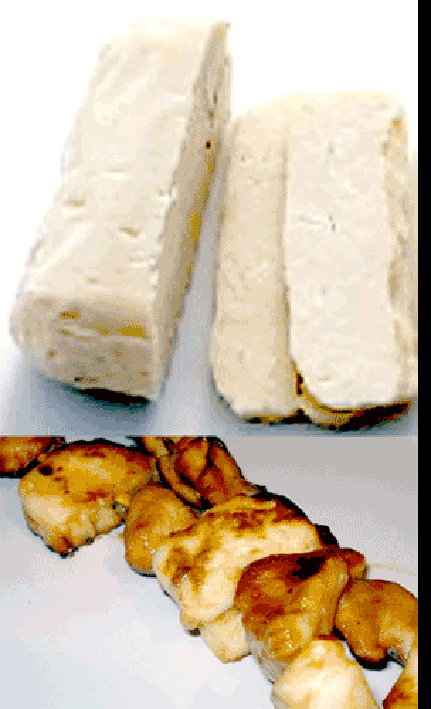 Sliced halloumi cheese and barbecued cubes of halloumi.
Sliced halloumi cheese and barbecued cubes of halloumi.
Welcome to the summary page for FabulousFusionFood's Cook's Guide entry for Halloumi along with all the Halloumi containing recipes presented on this site, with 4 recipes in total.
This is a continuation of an entire series of pages that will, I hope, allow my visitors to better navigate this site. As well as displaying recipes by name, country and region of origin I am now planning a whole series of pages where recipes can be located by meal type and main ingredient. This page gives a listing of all the Halloumi recipes added to this site.
These recipes, all contain Halloumi as a major wild food ingredient.
Halloumi is a traditional Cypriot cheese, typically made from a blend of sheep's and goat's milk (though it can be made from cow milk or a blend). It is also known in Greece, where it is called χαλούμι, in Turkey hellim, and the Middle East (in Arabic it is حلوم ḥallūm). Studies indicate that Halloumi originated in Cyprus and was initially made during the Medieval Byzantine period and it was from there that it spread throughout the Middle East.
Halloumi is a semi-hard, unripened brined cheese that is traditionally set with rennet. It has a very mild flavour, partly because it is not matured and partly because not acid or acid-producing bacteria are used in its preparation. The cheese is also unusual in that it has a very high melting point, which makes it eminently suitable for frying or grilling.
The cheese is white, with a distinctive layered texture, similar to mozzarella and has a salty flavour. It is stored in its natural juices with salt-water and can keep for up to a year if frozen below −18°C and defrosted to +4°C for sale. Traditionally, it was wrapped in mint leaves, which acted as a preservative. This practice arose from the serendipitous discovery that Halloumi kept better and was fresher and more flavoursome when wrapped with mint leaves. In accordance with this tradition, many packages of halloumi contain fragments of mint leaves on the surface of the cheese and halloumi cheese is typically served with a sprig of mint.
Halloumi's resistance to melting comes from its method of preparation. When it is made, the fresh curds are heated before being shaped and placed in brine. Though not sold outside Cyprus and the Middle east, there is also an aged form of Halloumi which is matured in its won brine. It is is much drier, much stronger and much saltier than unaged Halloumi.
This is a continuation of an entire series of pages that will, I hope, allow my visitors to better navigate this site. As well as displaying recipes by name, country and region of origin I am now planning a whole series of pages where recipes can be located by meal type and main ingredient. This page gives a listing of all the Halloumi recipes added to this site.
These recipes, all contain Halloumi as a major wild food ingredient.
Halloumi is a traditional Cypriot cheese, typically made from a blend of sheep's and goat's milk (though it can be made from cow milk or a blend). It is also known in Greece, where it is called χαλούμι, in Turkey hellim, and the Middle East (in Arabic it is حلوم ḥallūm). Studies indicate that Halloumi originated in Cyprus and was initially made during the Medieval Byzantine period and it was from there that it spread throughout the Middle East.
Halloumi is a semi-hard, unripened brined cheese that is traditionally set with rennet. It has a very mild flavour, partly because it is not matured and partly because not acid or acid-producing bacteria are used in its preparation. The cheese is also unusual in that it has a very high melting point, which makes it eminently suitable for frying or grilling.
The cheese is white, with a distinctive layered texture, similar to mozzarella and has a salty flavour. It is stored in its natural juices with salt-water and can keep for up to a year if frozen below −18°C and defrosted to +4°C for sale. Traditionally, it was wrapped in mint leaves, which acted as a preservative. This practice arose from the serendipitous discovery that Halloumi kept better and was fresher and more flavoursome when wrapped with mint leaves. In accordance with this tradition, many packages of halloumi contain fragments of mint leaves on the surface of the cheese and halloumi cheese is typically served with a sprig of mint.
Halloumi's resistance to melting comes from its method of preparation. When it is made, the fresh curds are heated before being shaped and placed in brine. Though not sold outside Cyprus and the Middle east, there is also an aged form of Halloumi which is matured in its won brine. It is is much drier, much stronger and much saltier than unaged Halloumi.
The alphabetical list of all Halloumi recipes on this site follows, (limited to 100 recipes per page). There are 4 recipes in total:
Page 1 of 1
| Makaronia Pastitsio (Macaroni with Minced Meat and Bechamel Sauce) Origin: Cyprus | Stuffed Peppers with Sweet Potato Mash Origin: Fusion |
| Mediterranean Lamb in a Dijon Mustard Sauce Origin: Mediterranean | Warm Halloumi and Fennel Salad Origin: Cyprus |
Page 1 of 1